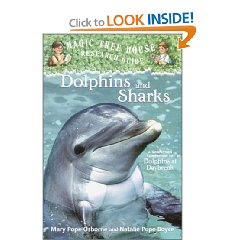And toss in some sharks, manta rays, otters and penguins for good measure. Maybe the study should be called 'Sea Mammals and Fish', or 'What's in the Ocean?'. The study is getting bigger everyday as we follow tangents here and there.
All I can say is........I want to hang out with a Bottlenose Dolphin. Or a baby Harbor Seal. And we'll steer clear of the Leopard Seals - watch out for those guys!
Here are some of the resources and ideas we are using for this study. Please note we have not completed this unit study and we'll pick up where we left off once we are on the other side of the holidays. It's time for Christmas break around here! I will update materials as they are used, but this is where we started in our effort to learn more about the magnificent creatures of the sea. And the sea itself.
NOTE: This study took eight weeks to complete and we didn't work on it every day.
SCIENCE
The Ocean Book: Aquarium and Seaside Activities and Ideas for All Ages by the Center for Marine Conservation - easy experiments mixed in with all sorts of worthwhile information and fun things to do like crossword puzzles and quizes. This is a good starting place from which to branch off of. I picked up a copy of this at the Shedd Aquarium in Chicago a few weeks ago and am glad it's in our library now.
Accompanies Mary Pope Osborne's Dolphins at Daybreak. Good overall research guide about dolphins and sharks, basic information, very easy to read and digest.
Bill Nye always elicits a smile from his audience. Simple experiments sprinkled amongst pages of interesting ocean knowledge.
Seriously excellent resource not to be missed. If you get your hands on it, treasure it! Magnificent drawings and photographs that peek into the elusive lives of sea mammals.
Here is a list of the scientific concepts we have been covering:
types of whales (baleen and toothed), differences in anatomy and movement between fish and whales, blubber (thermoregulation) and buoyancy, migration patterns of whales, types and causes of the tides, food chain and energy required to sustain the toothed whales versus the baleen whales, salinity of ocean water, types of ocean currents and their purposes (like thermohaline), the Coriolis Effect (the differences between currents in the northern and southern hemispheres and how they act), the ecological balance of the ocean and how crucial it is to life on land, scientific classification of whales and dolphins, oceanographers and what they do, depth and layers of the ocean, pressure within the ocean, flotsam and jetsam (which means we all need to pay attention to recycling!), how some cultures are particularly dependent on the sea for life, wind waves versus tsunami waves and what causes tsunamis, etc., etc., etc.!
LITERATURE
Just finished this book. It's an excellent 'read aloud' book with a Robinson Crusoe feel. A young Indian woman is stranded on an island, left by her people to fend for herself. And fend she does. She is a smart survivor who uses her resources and overcomes her loneliness by connecting with the wild animals around her. Based on a true story of a woman from the Ghalas-at tribe who was stranded on Saint Nicolas Island off the coat of California from 1835 to 1853 and subsequently rescued. Max enjoyed the way she treated the animals on the island, how she befriended and tamed several of them. Nice imagery that captures daily life dependent on the sea.
A quick read. I like the research guides that accompany some of Mary Pope Osborne's books.
Please see the separate post about the Great Illustrated Classics series under the Literature category on the left. These are gentled-down versions of epic tales that maintain their character and essence. Perfect for this age group of readers. Of course we need to read about Captain Ahab and Moby Dick! The unit study wouldn't be the same without them.
A detailed and magical look at the life of Humpback whales because in the book an eleven-year old girl falls out of a boat and turns into a whale. Lovely imagery and immersion into the environment of the whale. Truth be told, I cried at the end of this book and couldn't read out loud, so Max had to read to me for awhile. It was very sad when she said goodbye to her whale family. It made me wail. We learned, among other specifics, about the migratory pattern of the Humpbacks. Cool.
The 1938 classic tells the story of Mr. Popper, the small-town house painter who dreamed of exploring Antarctic regions, and Captain Cook, the redoubtable penguin who turned Mr. Popper's world upside down. Newberry Honor Book (description cut and pasted from trusty Amazon). A fun story about a gentleman's love for his penguins and his ingenuity in creating an interesting life for himself and his family of humans, too.
This charming story would fit nicely into this unit study. We read it together last summer and it is one of those books so full of brilliant imagery, that it stays with you for a long time. It's about a baby gray whale who has gotten separated from his migrating pod and a determined woman bent on reuniting him with his mother. Beautiful story on many levels.
WRITING
When we finish a book from our literature choices, Max writes a summary of the book. Lately he's been dictating them to me, then I print them out double or triple-spaced and ask him to edit his writing. This method is working well so far. Writing is another subject he is resistant to and that's okay. That will come in time and I'm not worried about it. His imagination is intact and active - I can help him get his thoughts down on paper and he can take it from there.
GEOGRAPHY
We've been following where the dolphins or other sea mammals take us. The Bahamas where Spotted Dolphins frolic, Argentina where Dusky Dolphins swim the waters, St. Nicolas Island off the coast of California where "Karana" of the Island of the Blue Dolphins lived alone for twenty years. Geography is naturally intermingled with a study of the oceans and the life they support. This topic will grow considerably as we travel through this unit.
Closeup view
Animals of the World by Dinosmaps
Bright and cheerful. Several maps to choose from; we've been referring to this one frequently during this unit. I found these maps at Costco for $6.99 each.
MATH
One day we braved the elements with some trusty sidewalk chalk and measured the length of various baleen and toothed whales on the pavement. The Blue Whale measures in at a whopping 100+ feet! I stood at his 'head', Max at his 'tail fluke' and we waved at one another across the great expanse. It was very helpful to visualize just how big these mighty and beautiful creatures are.
I'm sure we'll come up with more math applicable to sea mammals; in the meantime there will always be fractions or prime numbers or Penrose to entertain us. Or we can always count plankton.
DVD's
Pierce Brosnan narrates this video nicely. I always did like him. It highlights Spotted Dolphins in the Bahamas and Dusky Dolphins in Argentina and some researchers studying communication patterns in dolphins.
After watching this, Max declared that he wants to be a marine scientist who works in an aquarium and trains the animals. Cool! This is a look into the country's aquariums and the mission behind them. Particularly interesting for me since we just visited the Shedd Aquarium in Chicago two weeks ago and that aquarium's history was highlighted.
No comment needed. Just a movie we hadn't seen before - no kidding!
Wonderful. Wonderful. Wonderful.
Cruise with the crew of the Sea Shepherd and get emotionally involved with the effort to stop whaling.
Of course we don't have the IMAX setup in our living room, but it's still good. A scientist is studying a unique type of jellyfish in a closed ecosystem in the Islands of Palau in the South Pacific - a 'salt lake'. The jellies have evolved and no longer need to sting. Particular to whales, scientists are studying their populations as markers of health of the world ocean.
Every time we sit down to watch an episode we are filled with wonder. David Attenborough's voice is very soothing - he is a gem of a narrator. This is Part 3 of the "Seas of Life" BBC DVD series. This entire set is worth owning because you'll want to return to it again and again. We're currently enjoying it via instant play from Netflix.
444 nearly five-star ratings. That many people can't be wrong! Max seems to have a particular interest in Antarctica.
GAMES
I posted separately about this game earlier this month stated as such: in a nutshell, you are playing 'Go Fish', but with pictures and words that you choose based on what you are studying. I took a stack of index cards and cut each card in half. On one half of the card I drew a picture of say, diatoms or a tail fluke. On the other half of the card I wrote the corresponding word or term. Yes, I had to look up what diatoms look like. I'll list the words/pictures we used below as these could be easily incorporated into a unit study about the ocean, marine life, marine mammals - whatever! This is an easy game to apply to any subject and you can make it as easy or difficult as you wish. I threw in some more difficult terms along with some very simple ones just to get us going. The idea is to become familiar with terminology and expand your understanding by matching words with pictures.
To play: deal each player four cards and well, play with the object of matching up pictures to words. Go Fish! Winner has the most pairs.
These are the terms we used. As we continue to work through this unit, it's easy to add new words/pictures and take away some of the old. For this unit I am using this concept in place of spelling - it's more of a vocabulary overview.
algae, Nansen bottle, nautilus, trilobite, diatoms, shrimp, baleen plates, Humpback whale, Marianas Trench, jellyfish, Cetacea, sea urchin, Indian, Pacific, Atlantic Ocean, manta ray, sea anemone, lateral line, kelp, mermaid, coral reef, flippers, oil platform, octopus, dorsal fin, caudal fin, tail fluke, echolocation, harbor, wet suit, sea monster, eel, waves, Moby Dick, supertanker, oyster, starfish, submarine, oceanographer, pectoral fins, squid - etc, etc, etc - use your imagination and your research resources to pull terms.
OTHER BOOKS WE ARE LOOKING FORWARD TO:
The yellow rubber ducky bobbing up and down in your bath water will take on a whole new identity after you read this book. Tracking Trash: Flotsam, Jetsam, and the Science of Ocean Motion. Nice and somewhat shocking way to learn about the currents in the ocean. We really need to stop using plastic bags.........
Contains much information about the 2004 tsunami in Indonesia; a rather humbling account of nature's power.
I WILL ADD MORE IDEAS AND RESOURCES AS WE USE THEM!
January, 2010..........Guess what? I found more ideas and resources!
The Intellego Unit Study on Whales looks fantastic and we'll begin doing some work out of it tomorrow. It is a THOROUGH study that is Internet-linked and filled with hands-on activities. I bought it as a downloadable .pdf, so will print out only the sections we see a need to. If you are curious about Intellego Unit Studies, there is a post dedicated just to them in this blog.
What Do You Know about Oceans? Knowledge Cards Deck
Also, these Knowledge Cards from Pomegranate look useful, too.
Found this on Max's shelf a few days ago. It must have come from a scholastic book fair back in the day when he attended 'regular' school. Written for a slightly younger audience, but still worthwhile and information-packed. I like how real scientists are listed and incorporated into the books.

























































